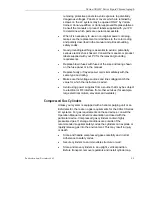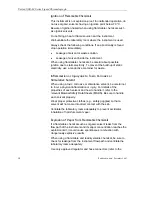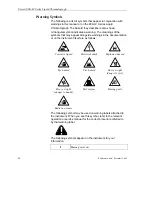
Varian 900-LC Series Liquid Chromatograph
Ignition of Flammable Chemicals
This instrument is not explosion-proof. In unattended operation, do
not use organic solvents having an ignition point below 70 °C.
Beware of ignition hazard when using flammable chemicals such
as organic solvents.
Do not bring a heat or flame source near the instrument.
Well-ventilate the laboratory room where the instrument is used.
Always check the following conditions. If an abnormality is found
stop operation immediately.
•
Leakage of solvent or waste solution.
•
Leakage of solvent inside the instrument.
When using flammable chemicals, be careful about possible
ignition due to static electricity. To prevent the build-up of static
electricity, use a conductive container for waste.
Inflammation or Injury due to Toxic, Corrosive or
Stimulative Solvent
When using a toxic, corrosive or stimulative solvent, be careful not
to incur a physical inflammation or injury. For details of the
properties of each solvent and how to handle it, refer to the
relevant Material Safety Data Sheets (MSDS). Be sure to handle
each solvent properly.
Wear proper protective clothes (e.g., safety goggles) so that a
solvent will not come into direct contact with the skin.
Ventilate the laboratory room adequately to prevent accidental
inhalation of harmful solvent vapor.
Explosion of Vapor from Flammable Chemicals
If a flammable chemical such as organic solvent leaks from the
flow path of the instrument and its vapor concentration reaches the
explosion limit, it could cause spontaneous combustion with
dangerously explosive results.
When using a flammable and readily volatile chemical, be sure to
check for leakage from the instrument flow path and ventilate the
laboratory room adequately.
Use only approved regulator and hose connectors (refer to the
14
Publication date: December 2007















































